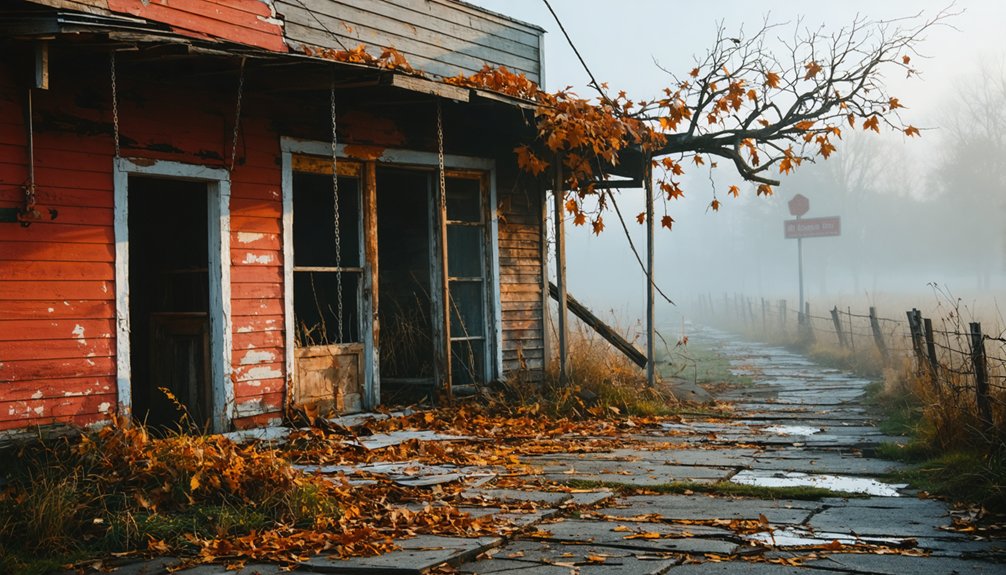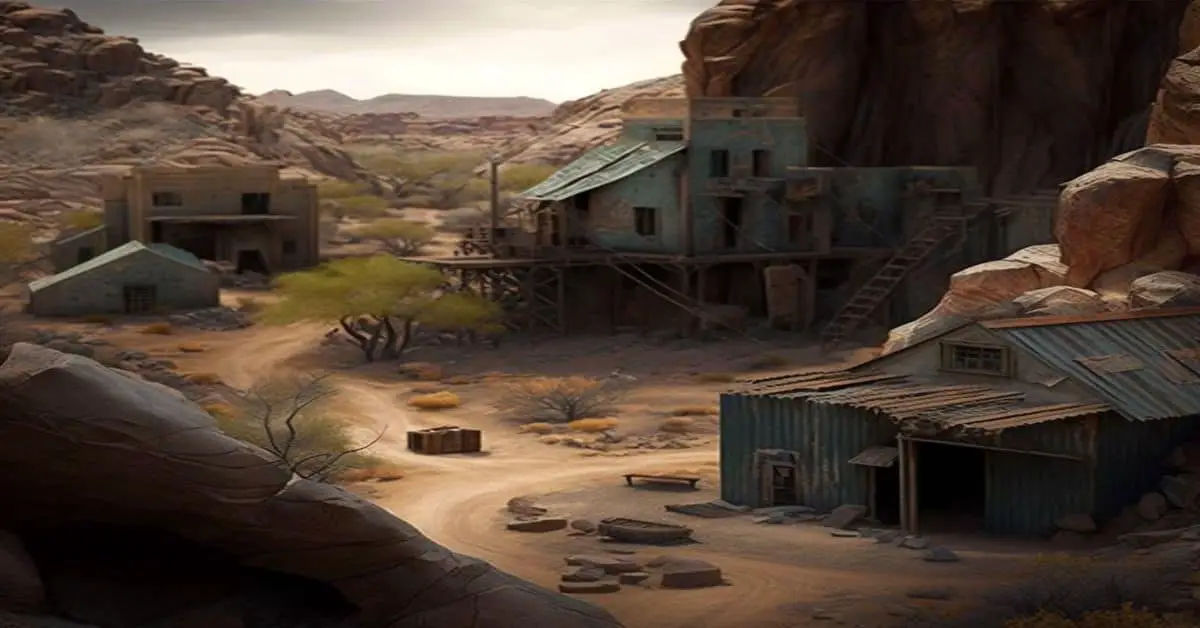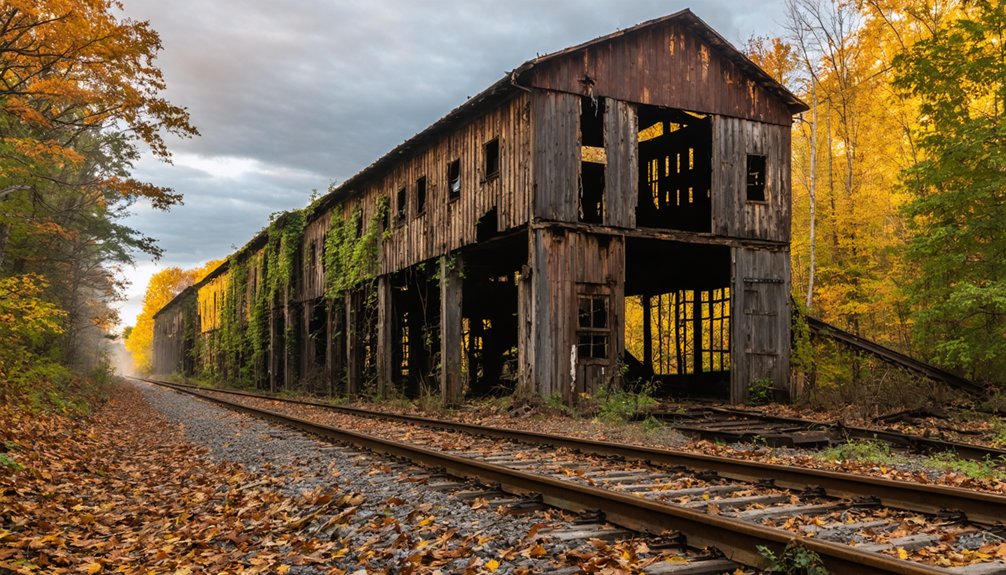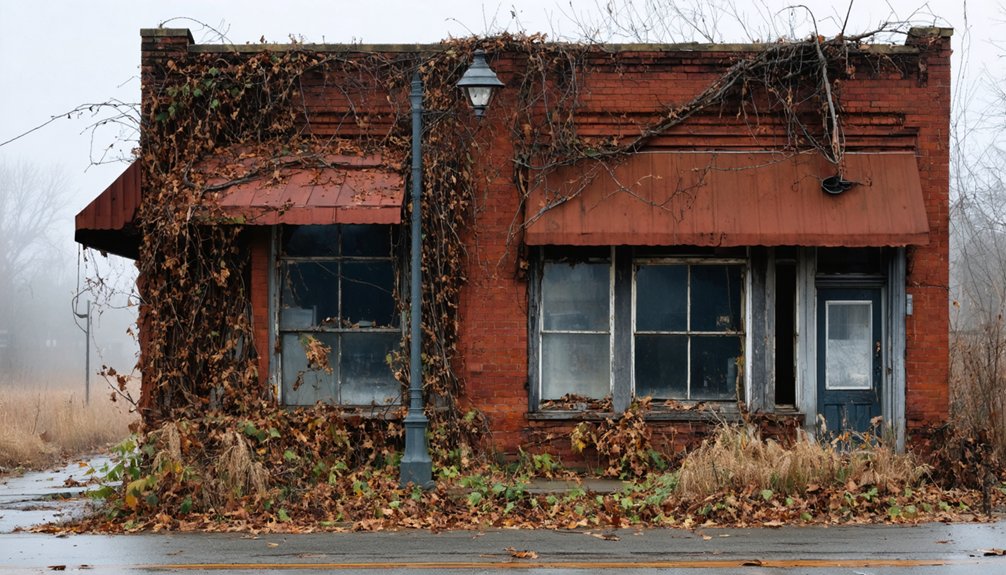You’ll find West Union’s remains 16 miles north of Vincennes, Indiana, where a vibrant Shaker settlement once thrived from 1808 to 1826. The community, initially known as Busro, grew to 300 members who practiced communal living and spiritual equality along Busseron Creek. Despite their innovative farming and craftsmanship, the settlement struggled with Native American raids, malaria outbreaks, and harsh frontier conditions. The site’s archaeological discoveries continue to reveal secrets about this fascinating chapter of Indiana’s past.
Key Takeaways
- West Union was a Shaker settlement established in 1808 along Busseron Creek, 16 miles north of Vincennes, Indiana.
- The community thrived with 300 members by 1811 but faced challenges from Native American raids and disease outbreaks.
- Malaria epidemics and environmental hardships led to significant population decline in the 1820s.
- The settlement was officially abandoned in 1826, with structures falling into decay and mills ceasing operation.
- Archaeological excavations have revealed the planned layout and artifacts of this ghost town’s communal Shaker lifestyle.
The Rise of a Shaker Settlement
When Shaker missionaries first ventured into Indiana Territory in 1808, they established West Union as a promising frontier settlement along Busseron Creek.
You’ll find that this westernmost Shaker outpost, initially known as Busro, took root just 16 miles north of Vincennes and two miles east of the Wabash River.
The settlement’s growth reflected the strength of Shaker beliefs and community structure, as converts arrived by boat from Union Village, Ohio, and other settlements like Red Banks, Kentucky.
Dedicated Shakers journeyed by water from established settlements, bringing their faith and communal values to build this flourishing frontier outpost.
They created a thriving community that swelled to 300 members by 1811.
The settlement exemplified the Shakers’ dedication to spiritual equality, welcoming people of all races into their community.
The Shakers’ commitment to their faith drove them to develop a well-organized village near Fort Knox, where they’d build innovative structures and establish a self-sustaining community that would shape the region’s early development.
The New Madrid earthquakes in 1812 severely disrupted the settlement, leading to its temporary abandonment.
Daily Life in West Union
Life in West Union revolved around a tightly organized system of communal living, where Shaker families shared their daily routines in separate but interconnected households.
You’d find yourself immersed in a bustling community where farming, craftsmanship, and Shaker rituals shaped each day’s rhythm. Despite practicing celibacy, families lived together and participated in communal meals that strengthened their bonds. The community depended heavily on having access to clean drinking water for their daily needs. Like the town of Elkinsville before its submersion, West Union maintained a strong church presence at its core.
- You’d start your day with shared worship in the frame meetinghouse
- You’d work alongside others in the fields or craft workshops
- You’d gather for communal meals featuring locally grown produce
- You’d end your day with evening prayers and social gatherings
The settlement’s location near the Wabash River supported agricultural activities, while various workshops buzzed with weaving and woodworking.
Though challenging at times, this lifestyle fostered a strong sense of community and purpose.
Struggles on the American Frontier
Despite the Shakers’ vision of a peaceful frontier settlement, West Union faced formidable challenges that tested the community’s resilience in the early 1800s. You’d find settlers confronting multiple threats, from Native American raids to militia conflicts, with Fort Knox’s presence offering limited protection. The territory’s turbulent history included intense fighting during the French and Indian War between competing colonial powers.
Disease struck particularly hard, as malaria and fever outbreaks ravaged the population without adequate medical care. Similar to other settlements during the westward expansion, communities like West Union struggled to maintain populations as disease and hardship took their toll.
The frontier challenges extended beyond safety concerns. You’d see the community struggling with unpredictable weather affecting their crops along Busseron Creek, while limited access to markets hampered economic growth.
Young members began departing by the 1820s, seeking better opportunities elsewhere. Though the Shakers had established diverse industries including craft shops and farming operations, the combination of health crises, environmental hardships, and demographic decline ultimately proved too difficult to overcome.
The Final Years and Abandonment
The mounting challenges of frontier life ultimately proved fatal for West Union’s survival in the mid-1820s.
You’ll find that a perfect storm of hardships converged to seal the settlement’s fate, with both environmental challenges and declining population playing decisive roles in its downfall.
- Malaria epidemics ravaged the community’s health, while droughts and floods destroyed essential crops.
- The fever outbreak of 1825 triggered a mass exodus of young Shakers.
- By mid-decade, the population had dwindled to roughly 100 members.
- The remaining Shakers officially abandoned West Union in 1826.
The devastating loss of structures continued well beyond West Union’s time, as evidenced when the East Union Baptist Church burned down.
The community’s final years saw their mills fall silent, buildings decay, and farmland productivity plummet.
Despite attempting to relocate within their territory, the Shakers couldn’t overcome these obstacles and ultimately dispersed to other Midwestern settlements.
Archaeological Findings and Historical Legacy
Since the settlement’s abandonment in 1826, archaeological excavations have revealed a wealth of insights into West Union’s distinctive Shaker way of life. Through artifact analysis, you’ll find evidence of a meticulously planned community with specialized workshops, communal living spaces, and locally crafted goods that embodied Shaker values of simplicity and self-sufficiency.
Recent genetic analysis techniques similar to those used in studying the 4,000-year-old skull found nearby could provide deeper understanding of the settlement’s inhabitants. The site’s layout included a substantial two-story brick Center Family house, multiple workshops, and a grand meetinghouse – all indicators of the Shakers’ organizational prowess.
However, preservation challenges have complicated research efforts, with erosion, agricultural activity, and looting threatening the site’s integrity. Despite these obstacles, West Union’s remains continue to provide valuable insights into religious communitarianism and frontier adaptation, marking it as a significant piece of Indiana’s early settlement history.
Frequently Asked Questions
What Happened to the Shakers’ Personal Belongings When They Abandoned West Union?
You’ll find that Shaker relics were either taken by departing members to other communities or managed by leadership for distribution. Historical preservation efforts later documented remaining belongings through archaeological surveys and records.
Did Any Non-Shaker Settlers Attempt to Occupy the Abandoned Settlement Afterwards?
You won’t find evidence of non-Shaker settlers attempting to occupy West Union’s abandoned properties. Despite common settler motivations to claim empty frontier sites, historical records show no documented reoccupation attempts.
Were There Any Documented Supernatural Occurrences at the West Union Site?
You won’t find any documented supernatural sightings or ghostly encounters at this location. Unlike other Indiana ghost towns with rich paranormal histories, there’s no evidence of supernatural activity in historical records.
How Did Local Native American Tribes View the Shaker Settlement?
Despite sharing territory with 5+ tribes, you’ll find no clear tribal perspectives documented – records show neutral or avoidant cultural interactions, with Native Americans neither viewing Shakers as threats nor allies.
What Modern-Day Landmarks Help Visitors Locate the Former West Union Settlement?
You’ll find a historical marker on U.S. 41 near Oaktown that points to the ghost town’s location, though the actual site remains on private farmland northwest of town.
References
- https://www.in.gov/history/files/42.1966.1Shakertown.pdf
- https://indianahistory.org/wp-content/uploads/west-union-shaker-village-archaeological-survey.pdf
- https://lostinthestates.com/category/ghost-towns/
- http://freepages.rootsweb.com/~gtusa/history/usa/in.htm
- https://theclio.com/tour/2163
- https://en.wikipedia.org/wiki/List_of_ghost_towns_in_Indiana
- https://scholarworks.iu.edu/journals/index.php/imh/article/download/7027/7768/20010
- https://en.wikipedia.org/wiki/Chronology_of_Shakers
- https://socialwelfare.library.vcu.edu/religious/the-shakers-a-utopian-community-founded-in-u-s-1776/
- https://www.hmdb.org/m.asp?m=226327



